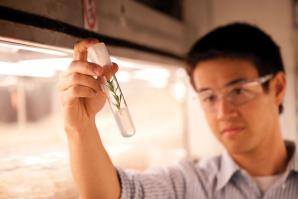In a growing cluster of offices and labs south of downtown Davis, researchers at Novozymes Inc. are building better microbes.
They create and improve microscopic organisms that make chemicals — enzymes, used to make everything from beer and bread to paper to leather to fuel. The Danish biotech company is one of the biggest private employers in Davis. As of late 2009 it employed 108 here, up 59 percent in four years, and it added two buildings to its Davis research complex last year to accommodate growth.
The biggest source of growth for the site is enzyme research for production of ethanol and other compounds from biomass. Early in 2010 Novozymes launched two new enzyme products, developed here, that can be used to produce ethanol fuel from plant waste at a price competitive with gasoline or ethanol made from corn.
Commercial ethanol production now largely uses corn or other food plants, and many fear that using it for large-scale fuel production would drive up food prices. The Novozymes products launched in February can be used to break down corn cobs or stalks, wood chips, wheat straw and other fibrous plant parts into sugars for ethanol production at less than $2 a gallon, says Sarah Teter, a staff scientist with Novozymes in Davis. Partners that are developing commercial-scale production plants around the world to use the technology could be up and running by late 2011, she says.
And ethanol is just the beginning. Novozymes is a major player, but its competitors and chemical and energy companies around the world also are turning their attention to using the sugars in plants — including the structural material in plant cells known as cellulose, which is made up of long chains of sugars — as the fundamental building blocks of a new set of industrial processes. Ultimately, such a shift could lead to biorefineries that convert switchgrass or other renewable crops into fuels, plastics, fertilizers and other components of the industrial world that now are built on a foundation of crude oil.
Oil is expensive in many ways. Burning it releases carbon dioxide, which research indicates is a major contributor to climate change. Extracting it can be an environmental nightmare, securing access to it can lead to changes in foreign and military policy with global repercussions and, eventually, the finite supplies of oil will dwindle, driving up costs, worsening conflicts and potentially causing economic turmoil. Some analysts believe the world may already have hit its “peak oil” stage with production declines on the horizon, while others put it a decade or more away.
That specter is helping to drive a wave of investment in alternatives. “The best indicator of the shift is to look at global energy and chemical leaders and the investments (they make),” says Matt Carr, managing director for policy with the Biotechnology Industry Organization trade group in Washington. In recent years “all of them have invested in bio-based alternatives to transportation fuels, energy or both. … Even if we’re decades from a peak oil situation, it makes sense to diversify the feedstock base.”
Novozymes projects the U.S. biofuel industry will produce about 12.5 billion gallons of ethanol in 2010.
Developing cellulosic biofuels “can make a significant dent in the amount of fuel we have to import from areas we’d rather not import from,” says Gary Koppenjan, spokesman for Ceres Inc. of Thousand Oaks, a biotech company that develops genetically altered switchgrass and other plants for fuel production and is collaborating with Novozymes. Plant-based fuels produced domestically, he says, have the potential to replace the amount of fuel the United States now imports from Venezuela and the Middle East combined.
Ethanol has been a hotly contested ground in the shift from oil to plants, with President George W. Bush emphasizing cellulosic ethanol technology during his 2006 State of the Union address. It’s already familiar as a component of blended gasoline (not to mention liquor), and corn-based ethanol production is well established in the Midwest and around the U.S. Sacramento-based Pacific Ethanol Inc. is the leading West Coast marketer and producer, and its executives have said that corn-based ethanol investment “lays the groundwork” for a transition to renewable fuel from plant waste.
“Ethanol is a great place to start because we’ve been fermenting ethanol from sugars for centuries,” Teter says.
But work is advancing in many other fields, too. At least three ventures in the United States are making plastics from corn or sugar cane rather than oil, says BIO spokesman Paul Winters. A World Economic Forum report released this summer (and prepared in collaboration with Novozymes, DuPont, Brazilian petrochemical conglomerate Braskem SA and other industry giants) says biorefineries could play a key role in reducing climate change and transitioning to more sustainable industry, and could generate hundreds of billions of dollars in revenue by 2030.
Novozymes sees its enzymes as a key component in the transition. “For me, this is all about trying to switch from oil to sugar,” Teter says. “Biofuels is just the first step in the biorefinery move for Novozymes, and that’s our vision.”
The company saw sales increase 13 percent in local currency during the first six months of 2010 from the same period in 2009. North American sales grew 11 percent year over year, driven “in particular (by) enzyme sales to the U.S. ethanol industry;” ethanol enzyme sales were up 26 percent. The company’s outlook for the year projected that the U.S. biofuel industry will produce about 12.5 billion gallons of ethanol in 2010.
The Davis operation is the spearhead of Novozymes’ work in enzymes for making fuel and chemicals from biomass, including the enzyme products launched this year. Roughly half of its 108 local workers are building, improving, identifying and testing microorganisms (and the enzymes they produce) for that biomass effort. The biomass work, in turn, is Novozymes’ single biggest research initiative, employing the equivalent of 150 full-time workers around the globe, Teter says.
“We’re trying to make a lock that’s more easily opened, and Novozymes is developing a better key.”
Gary Koppenjan, spokesman, Ceres Inc.
The 25,000-square-foot expansion in Davis last year brought the complex to 60,000 square feet and makes room for more researchers. Inside, scientists in lab coats and protective gear handle genetically altered fungi and bacteria, growing strains on petri dishes.
To improve the performance of the strains they create, they induce mutations, then test the results to see whether they are more effective or cheaper. Some of the testing is automated with robotic equipment quickly reviewing thousands of variations. (A sign on the testing area door warns, “Authorized Robots Only.”)
Elsewhere in the lab, flasks of material are swirled in small-scale fermenters that allow researchers to test which combinations of nutrients, oxygen, acidity and other factors will create optimal conditions to produce enzymes. The best strains — packaged in vials or sealed in plastic on a covered glass dish — are sent to the Novozymes production plant in Franklinton, N.C. There, the end products are packaged in fabric bales of enzyme powder several feet on a side or in giant plastic barrels for shipment to customers.
Otherwise, no living altered microbes leave the site. In Davis, one area where equipment is held for sterilizing in an autoclave bears a sign with a tiny tombstone and skull and crossbones, reading “To be killed.”
The enzymes are made to be part of an industrial production process, and Novozymes has formed partnerships with companies from China to India to Brazil to streamline development. In the collaboration with Ceres, Koppenjan says, Novozymes will work on more efficient ways to liberate the key chemicals from switchgrass and sorghum, while Ceres will try to increase crop yields and develop plants that are easier for the enzymes to break down. “It’s sort of like a lock and a key,” he says. “We’re trying to make a lock that’s more easily opened, and Novozymes is developing a better key.”
Technology alone won’t drive the transition. With investment money still tight and economic softness removing some of the pressing urgency, backers of alternative fuels are lobbying to increase mandates for ethanol use. For instance, some would like to see government incentives for use of “flex-fuel” vehicles, which can burn a gasoline blend that’s 85 percent ethanol, or raising the 10 percent limit on ethanol in standard gasoline to 15 percent.
Recommended For You

Killer Instincts
Butchery is finding a passionate female following
On a warm afternoon, soft spring winds are blowing across the campus at UC Davis. In a building on the university’s west corner, Cindy Garcia is hosing pools of blood down a drain. She places a pig skull on an inspection table, washes her hands and steps into the sunlight just as the parking lot is beginning to fill with shoppers toting grocery bags.

Genetically Engineered Industry
The Capital Region holds promise for agricultural technology
A few months after the 2002 launch of Arcadia Biosciences Inc. in Phoenix, CEO Eric Rey insisted the company move to California. Not to Silicon Valley, but to Davis.



